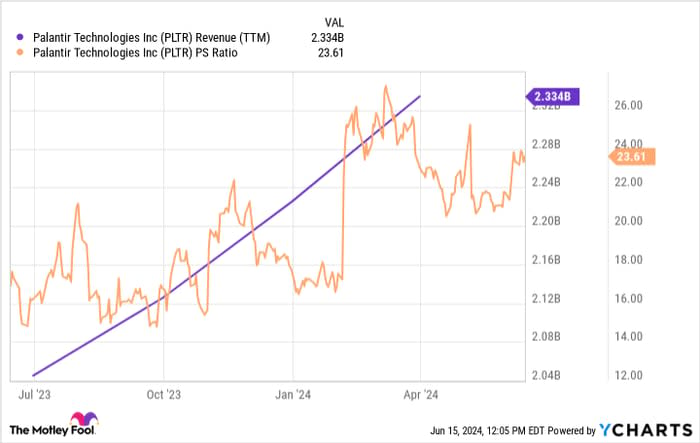Will Palantir Technologies Be a Trillion-Dollar Stock by 2030?
Software company Palantir Technologies (NYSE: PLTR) has been a big winner since artificial intelligence (AI) became a focal point for Wall Street. The stock has appreciated over 300% since January 2023, shortly after the explosion of ChatGPT's popularity.
Palantir is worth over $50 million in market cap today, and the company's growth prospects look bright. Some say that Palantir is poised to become the next "big technology" company, joining the likes of Nvidia and Microsoft in the trillion-dollar club.
Let's pump the brakes: That's roughly a 20x increase from where the stock is today. But what about the future, by, say, 2030? This Fool looked at the numbers to see how likely that might be. Here is what you need to know.
Why the optimism about Palantir's future?
Palantir builds custom software applications on its four primary platforms: Foundry, Gotham, AIP, and Apollo. Apollo deploys and manages these applications, while the others serve specific purposes.
Gotham is a commercially available "operating system" software that helps organizations run more efficiently. Foundry is used heavily by the government to connect data to real-time operations. Lastly, AIP, or artificial intelligence platform, is Palantir's newest product for developing and launching AI applications.
Artificial intelligence has sparked a frenzy of companies rushing to adopt and utilize AI in their businesses. You see this evidence everywhere. Big technology companies have fused AI capabilities into their core products. Enterprise software companies across Wall Street are doing the same, and the major cloud platforms are investing billions of dollars to acquire the AI chips needed to support this demand (look at Nvidia's rampant growth).
It appears that Palantir is in the right place at the right time. Palantir's software is complex and often mysterious, especially with government applications. However, one could point to Palantir's long-term relationship with the U.S. government to indicate that its technology can generate positive real-world value for customers. Additionally, you can look at the increasing sales momentum since Palantir launched AIP a year ago:
PLTR Revenue (Quarterly YoY Growth) data by YCharts
The company's customer count rose 42% year over year in Q1, including a 69% bump in U.S. commercial clients to 262. Palantir's remaining deal value (value of future business awarded but not billed) rose the most, jumping 74% over the prior year. It all points to a continued acceleration of revenue growth, which is very promising, considering this might be the beginning of a multiyear growth era as AI technology matures and spreads.
A trillion-dollar market cap is a high bar to clear
Palantir has some significant growth potential. But still, going from a $50 billion valuation to $1 trillion is a tall task.
Remember, this is a business that, while exciting, is still doing "just" $2.3 billion in annual revenue. The stock's massive move has partly come from a steeper valuation in addition to growth. Valuations don't go up forever, so Palantir must grow significantly for years to approach a $1 trillion market cap.
PLTR Revenue (TTM) data by YCharts
According to consensus analyst estimates, Palantir's 2024 revenue will be $2.7 billion, a 30% increase over 2023. AI could reasonably fuel prolonged growth, but investors should keep expectations realistic. For this exercise, I will cap annual revenue growth at 30%, but give a "nod" to AI's upside by assuming Palantir grows at 30% annually for the next six years.
That would mean that Palantir will generate approximately $13 billion in revenue in 2030. Using today's price-to-sales ratio (P/S), this would generate a 2030 market cap of $338 billion.
Is Palantir a future trillion-dollar stock?
The math shows that growing to such a high market cap by 2030 will be challenging. Palantir's stock is already valued near its highest P/S ratio in a year, while the broader market sits at all-time highs. I wouldn't count on that valuation over the long term. Instead, Palantir will need to grow revenue significantly higher than expected to have a realistic shot at a trillion-dollar valuation.
That doesn't account for long-term risks like competition or uncertainty about how much companies can and will spend on Palantir's products and services. Palantir's product can be remarkable, but it's reportedly expensive to purchase, which could limit its customer base over time.
Palantir could eventually become a trillion-dollar stock; it's just not likely to happen in the next six years. No worries -- it's still a fantastic business, with excellent fundamentals and accelerating revenue growth. The future looks bright, whether at a $1 trillion market cap or not.
Should you invest $1,000 in Palantir Technologies right now?
Before you buy stock in Palantir Technologies, consider this:
The Motley Fool Stock Advisor analyst team just identified what they believe are the 10 best stocks for investors to buy now… and Palantir Technologies wasn’t one of them. The 10 stocks that made the cut could produce monster returns in the coming years.
Consider when Nvidia made this list on April 15, 2005... if you invested $1,000 at the time of our recommendation, you’d have $775,568!*
Stock Advisor provides investors with an easy-to-follow blueprint for success, including guidance on building a portfolio, regular updates from analysts, and two new stock picks each month. The Stock Advisor service has more than quadrupled the return of S&P 500 since 2002*.
*Stock Advisor returns as of June 10, 2024
Justin Pope has no position in any of the stocks mentioned. The Motley Fool has positions in and recommends Microsoft, Nvidia, and Palantir Technologies. The Motley Fool recommends the following options: long January 2026 $395 calls on Microsoft and short January 2026 $405 calls on Microsoft. The Motley Fool has a disclosure policy.


